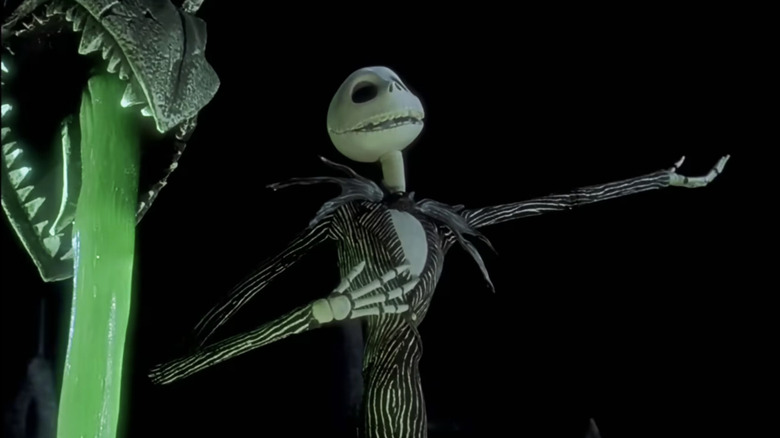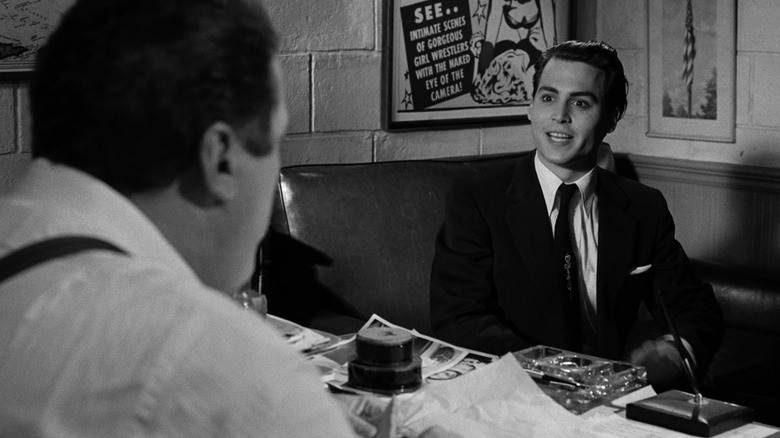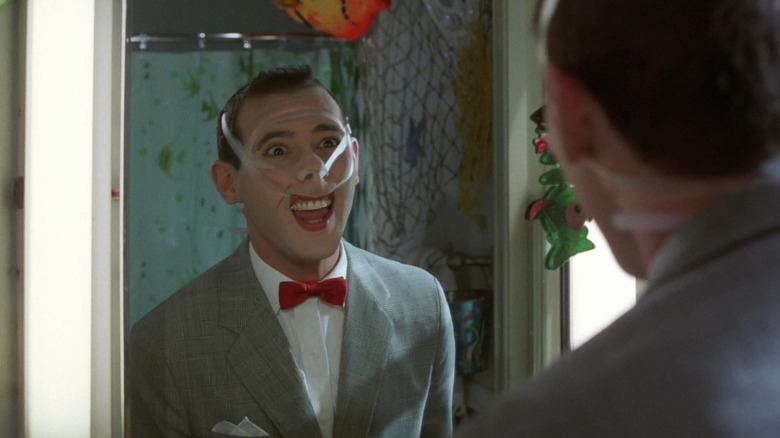Jack Skellington Was Partially Inspired By The Subject Of Another Tim Burton Movie
We may receive a commission on purchases made from links.
At the center of Henry Selick's animated 1993 cross-holiday classic "The Nightmare Before Christmas" (based on a poem and characters by Tim Burton) is Jack Skellington, a stick-like skeleton in a pin-striped tuxedo and outsize bat-shaped bow tie. Jack lives in Halloweentown, a city where all Halloween ghouls, monsters, and ghosts live during the off-season. In Halloweentown, 364 days a year are devoted to preparing for the upcoming All Hallow's Eve, with Jack serving as the city's most prominent civic leader. Jack is not the Mayor of Halloweentown, but Halloween couldn't happen without him. Jack is played by Chris Sarandon while speaking and by Danny Elfman while singing.
Early in "Nightmare," however, Jack confesses (in a song) that the many years of skillfully scaring humans have left him hollow and dissatisfied. Something is missing in his life, but he can't quite identify what it is. He is melancholy. Jack thinks he finds what he's looking for when he accidentally ventures into the neighboring Christmastown, the city where Santa Claus lives. He feels something he hasn't felt before, but he has no word for the feeling.
Although he is a melancholy skeleton, Jack takes on a weird, cock-eyed optimism when he experiences Christmastown. His ghoulish origins leave him ill-prepared to understand the joys of Christmas, but Jack sees something he desperately wants to wrap his skull around. It won't be until the end of the film, when Jack finally stands face-to-face with the stitched-together rag doll Sally (Catherine O'Hara) that he'll finally realize that the thing he was missing ... was love. "The Nightmare Before Christmas" is a great film.
In Dana Jennings Jelter's new book, "Tim Burton's Nightmare Before Christmas: The Ultimate Visual History," Burton talked a little bit about Jack and the inspiration for his character. Burton confessed that the optimism of the character came directly from the shining-eyed 1950s B-movie filmmaker Edward D. Wood, Jr., incidentally the subject of Burton's own 1994 film "Ed Wood."
Jack Skellington was based on Edward D. Wood, Jr.
Those who have seen Burton's 1994 biopic "Ed Wood" will be able to tell you how perky and optimistic the title character was. Ed Wood (Johnny Depp) always dreamed of being a celebrity filmmaker like his idol, Orson Welles. The problem was, Wood's interests skewed toward the ... unconventional. Wood wanted to make monster movies and sci-fi pictures, loving horror down to his bones. When he met Bela Lugosi (Oscar-winner Martin Landau), his heart sang, and Wood began casting the (fallen) actor in his zero-budget productions. Wood was also very open about his comfort in bending gender norms, often directing his films while wearing women's clothes. Some have posited that Wood might have been trans, although the 1950s didn't yet have the vocabulary to describe people so succinctly.
Wood was also stymied by a complete and utter lack of talent. His scripts are weird, his dialogue inhuman, his storytelling acumen nonexistent. His passions superseded his skills. Wood's many fans respond to that passion and are tickled by how unguarded Wood was in his filmmaking enthusiasm, even if his scripts sucked. He was seen as a bad filmmaker, but he was still beloved.
Jack Skellington, Burton feels, is very similar. He was viewed by most people as "bad," but he was really just an enthused, bight-side-loving kind of guy. In Burton's words:
"Jack was always very positive, very energetic, and very misguided. Jack is an optimistic character. He's something that's perceived as scary or bad, but he is truly just a good person and a positive, artistic person. That's why I always loved Ed Wood, because it was like, 'He's horrible, but passionate and cares about something even if it's garbage.' I've always identified with those types of characters."
In those terms, one can see it.
Tim Burton loves outsiders
Tim Burton, as many critics have long observed, tends to tell stories about poetic and tortured outsiders. Sometimes his outsiders are too kooky and ambitious rambunctious for polite society (Beetlejuice, Pee-wee Herman, Ed Wood, the "Mars Attacks!" Martians), while others are sadder, quieter, lovelorn figures who lurk in the shadows (Batman, Edward Scissorhands, Victor and Emily from "Corpse Bride"). Jack Skellington belongs to both camps. He is a kooky outsider to the rest of the world (he's a Halloween ghoul built to frighten humans), but also a lovelorn outsider in his own city.
Burton admits an affinity for the outsider monsters, an interest he developed back in childhood watching films like James Whale's 1931 film "Frankenstein." He liked the idea of misunderstood monsters, creatures that emerged as more tragic than scary. Those interests, he said, dovetailed neatly with "The Nightmare Before Christmas." In his words:
"I grew up watching monster movies, and I felt all monsters were actually not villains but the most emotional characters in the films, like Frankenstein and King Kong. Every monster is perceived as the bad guy, but they're not that bad of a guy. They're tortured: they're misguided: but they're not bad people. Feeling how I did about Halloween and Christmas, with a certain opposite juxtaposition of those holidays, the story and the character came together based on a lot of feelings that I had about a lot of things."
Burton remained a mainstay in Hollywood throughout the '80s and '90s, making some of the most striking blockbusters ever produced. His "Batman" was one of the biggest movies of all time, and he continued to ply his unique aesthetic to many films for years thereafter.


